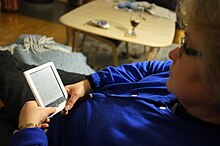
Back E-boek Afrikaans E-book AN كتاب رقمي Arabic ই-বুক Assamese ई-पुस्तक AWA Elektron kitab (sənəd) Azerbaijani E-Buach BAR Електронна книга Bulgarian Buku iliktrunik BJN ই-বই Bengali/Bangla

| E-commerce |
|---|
| Digital content |
| Retail goods and services |
| Online shopping |
| Mobile commerce |
| Customer service |
| E-procurement |
| Purchase-to-pay |
| Super-apps |
An ebook (short for electronic book), also spelled as e-book or eBook, is a book publication made available in electronic form, consisting of text, images, or both, readable on the flat-panel display of computers or other electronic devices.[1] Although sometimes defined as "an electronic version of a printed book",[2] some e-books exist without a printed equivalent. E-books can be read on dedicated e-reader devices, also on any computer device that features a controllable viewing screen, including desktop computers, laptops, tablets and smartphones.
In the 2000s, there was a trend of print and e-book sales moving to the Internet,[3] where readers buy traditional paper books and e-books on websites using e-commerce systems. With print books, readers are increasingly browsing through images of the covers of books on publisher or bookstore websites and selecting and ordering titles online. The paper books are then delivered to the reader by mail or any other delivery service. With e-books, users can browse through titles online, select and order titles, then the e-book can be sent to them online or the user can download the e-book.[4] By the early 2010s, e-books had begun to overtake hardcover by overall publication figures in the U.S.[5]
The main reasons people buy e-books are possibly because of lower prices, increased comfort (as they can buy from home or on the go with mobile devices) and a larger selection of titles.[6] With e-books, "electronic bookmarks make referencing easier, and e-book readers may allow the user to annotate pages."[7] "Although fiction and non-fiction books come in e-book formats, technical material is especially suited for e-book delivery because it can be digitally searched" for keywords. In addition, for programming books, code examples can be copied.[7] In the U.S., the amount of e-book reading is increasing. By 2014, 28% of adults had read an e-book, compared to 23% in 2013. By 2014, 50% of American adults had an e-reader or a tablet, compared to 30% owning such devices in 2013.[8]
Besides published books and magazines that have a digital equivalent, there are also digital textbooks that are intended to serve as the text for a class and help in technology-based education.
- ^ Gardiner, Eileen and Ronald G. Musto. "The Electronic Book." In Suarez, Michael Felix, and H. R. Woudhuysen. The Oxford Companion to the Book. Archived September 12, 2019, at the Wayback Machine Oxford: Oxford University Press, 2010, p. 164.
- ^ "e-book". Oxford Dictionaries. Oxford University Press. Archived from the original on February 8, 2011. Retrieved September 2, 2010.
- ^ "Print Book Vs E-book Sales Statistics – WordsRated". November 15, 2022. Retrieved December 27, 2023.
- ^ "What is an e-book?". WebWise. BBC. October 10, 2012. Archived from the original on February 4, 2017. Retrieved May 26, 2017.
- ^ eBook Revenues Top Hardcover – GalleyCat. Archived July 1, 2013, at the Wayback Machine. Mediabistro.com (June 15, 2012). Retrieved August 28, 2013.
- ^ Bhardwaj, Deepika (2015). "Do e-books really threaten the future of print?". The Times of India. Archived from the original on May 17, 2016. Retrieved May 6, 2016.
- ^ a b "e-book Definition from PC Magazine Encyclopedia". Archived from the original on August 7, 2017.
- ^ E-reading rises as device ownership jumps. Archived March 27, 2014, at the Wayback Machine. Pew Research. Retrieved July 24, 2014.